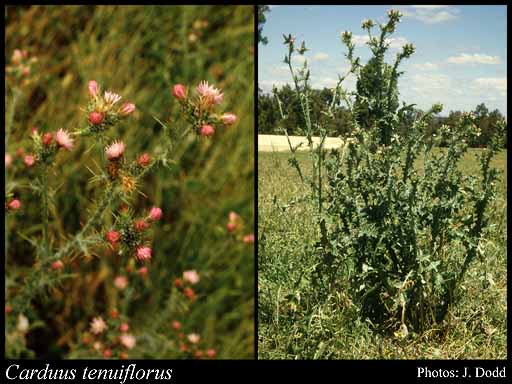- Reference
- Fl.Londin.Fasc. 6:Tab. 55 (1789)
- Conservation Code
- Not threatened
- Naturalised Status
- Alien to Western Australia
- Name Status
- Current
Erect, prickly annual or biennial, herb, to 1 m high. Fl. pink-purple, Sep to Nov. Weed of roadsides, pastures & dry open areas.







Distribution
- IBRA Regions
- Avon Wheatbelt, Coolgardie, Esperance Plains, Jarrah Forest, Mallee, Swan Coastal Plain, Warren.
- IBRA Subregions
- Eastern Goldfield, Fitzgerald, Katanning, Perth, Southern Jarrah Forest, Warren, Western Mallee.
- IMCRA Regions
- Central West Coast, Leeuwin-Naturaliste.
- Local Government Areas (LGAs)
- Albany, Boyup Brook, Bridgetown-Greenbushes, Busselton, Cranbrook, Gingin, Harvey, Jerramungup, Kalgoorlie-Boulder, Manjimup, Northam, Plantagenet, Ravensthorpe, Rockingham.
Management Notes (for the Swan NRM Region)
Alternative Names. Winged Thistle, Shore Thistle, Slenderflowered Thistle.
General Biology. Growth form. Herb. Life form. Annual. Reproduction. Seed. Dispersal. Wind, water, birds. Seedbank persistence. 10+ years.
Notes. Germination of seed is rapid and occurs at high rates. Germinates over a wide range of alternating temperatures up to 6 weeks after autumn rains. Produce two types of seed in each flower head. Those in the center are not dormant and are easily dispersed, while the outer seed can be dormant and have no obvious means of dispersal. Rust fungus as a biological control agent was released in southern Australia in 1993. Hybridisation with Carduus pycnocephalus is common.
Additional information. Origin. Macaronesia, Northern Africa, Europe. Similar exotic species. Carduus pycnocephalus.
Suggested method of management and control. Hand remove isolated plants through spring and early summer. Glyphosate at 50% applied by wick or 0.5% can provide some selective control. Alternatively spot spray Lontrel® 10 ml/ 10 L + wetting agent. Control at rosette stage. An integrated program involving a combination of techniques will be most effective. Read the manufacturers' labels and material safety data sheets before using herbicides. For further information consult the Australian Pesticides and Veterinary Medicines Authority to determine the status of permits for your situation or state.
Management Calendar
| Calendar Type | Jan | Feb | Mar | Apr | May | Jun | Jul | Aug | Sep | Oct | Nov | Dec | Comments |
|---|---|---|---|---|---|---|---|---|---|---|---|---|---|
| Germination | O | Y | Y | ||||||||||
| Active Growth | Y | Y | Y | Y | Y | ||||||||
| Flowering | Y | Y | Y | ||||||||||
| Fruiting | Y | Y | Y | ||||||||||
| Manual Removal | Y | Y | Y | Y | Y | ||||||||
| Herbicide Treatment | Y | Y | Y |
Legend: Y = Yes, regularly, O = Occasionally, U = Uncertain, referred by others but not confirmed.
References
- Brown, K. & Brooks, K. (2002) Bushland Weeds: A Practical Guide to their Management. Environmental Weeds Action Network, Greenwood.
- Dellow, J.J. (1996) Herbicide techniques for thistle management. Thistle management workshop, Canberra, Australia, 12-13 June 1996 (eds. T.L. Woodburn, D.T. Briese & S. Corey). Plant Protection Quarterly, 11 (Supp. 2): 276-277.
- Evans, R.A., Young, J.A. & Hawkes, R. (1979) Germination characteristics of Italian Thistle (Carduus pycnocephalus) and Slenderflower Thistle (C. tenuiflorus). Weed Science, 27 (3).
- Forcella, F. & Wood, H. (1986) Sequential flowering of thistles (Cynareae, Asteraceae) in southern Australia. Australian Journal of Botany, 34: 455-61.
- Groves, R.H. & Kaye, P.E. (1989) Germination and phenology of seven introduced thistle species in southern Australia. Australian Journal of Botany, 37 (4): 351-359.
- Hussey, B.M.J., Keighery, G.J., Dodd, J., Lloyd, S.G. & Cousens, R.D. (2007) Western Weeds. A guide to the weeds of Western Australia. 2nd Edition. The Plant Protection Society of Western Australia, Victoria Park.
- Moore, C.B. & Moore, J.H. (2002) Herbiguide, the pesticide expert on a disk. Herbiguide, PO Box 44 Albany, Western Australia, 6330.
- Moore, J.H. & Wheeler, J. (2008) Southern weeds and their control. DAFWA Bulletin 4744.
- Olivieri, I. (1985) Comparitive electrophoretic studies of Carduus pycnocephalus L., C. tenuiflorus Curt. (Asteraceae), and their hybrids. American Journal of Botany, 72 (5): 715-718.
- Olivieri, I., Swan, M. & Gouyon, P. (1983) Reproductive system and colonizing strategy of two species of Carduus (Compositae). Oecologia, 60 (1): 114-117.
- Parsons, W.T. & Cuthbertson, E.G. (2001) Noxious weeds of Australia. 2nd Edition. CSIRO Publishing, Collingwood.
- Swarbrick, J.T. & Skarratt, D.B. (1994) The bushweed 2 database of environmental weeds in Australia. The University of Queensland, Gatton College.
- USDA, ARS, National Genetic Resources Program (2009) Germplasm Resources Information Network - (GRIN). National Germplasm Resources Laboratory, Beltsville, Maryland. URL: https://npgsweb.ars-grin.gov/gringlobal/taxon/taxonomysimple.aspx - Accessed October 2009.